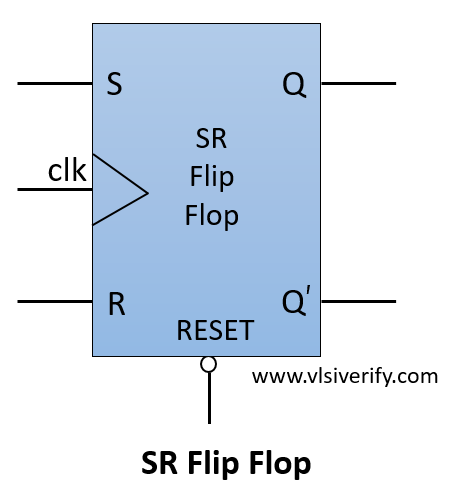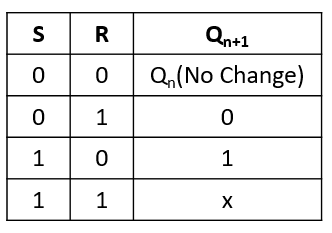Tutorials
Learn More
SR Flip Flop
The SR flip flop has two inputs SET ‘S’ and RESET ‘R’. As the name suggests, when S = 1, output Q becomes 1, and when R = 1, output Q becomes 0. The output Q’ is the complement of Q.
Block Diagram

Truth Table

For S = 1 and R = 1, output Q = x i.e. 1 or 0. Hence, S=1 and R=1 input combination is invalid and must be avoided in the SR flip flop.
SR Flip Flop Verilog Code
module SR_flipflop (
input clk, rst_n,
input s,r,
output reg q,
output q_bar
);
// always@(posedge clk or negedge rst_n) // for asynchronous reset
always@(posedge clk) begin // for synchronous reset
if(!rst_n) q <= 0;
else begin
case({s,r})
2'b00: q <= q; // No change
2'b01: q <= 1'b0; // reset
2'b10: q <= 1'b1; // set
2'b11: q <= 1'bx; // Invalid inputs
endcase
end
end
assign q_bar = ~q;
endmoduleTestbench Code
module tb;
reg clk, rst_n;
reg s, r;
wire q, q_bar;
SR_flipflop dff(clk, rst_n, s, r, q, q_bar);
always #2 clk = ~clk;
initial begin
clk = 0; rst_n = 0;
$display("Reset=%b --> q=%b, q_bar=%b", rst_n, q, q_bar);
#3 rst_n = 1;
$display("Reset=%b --> q=%b, q_bar=%b", rst_n, q, q_bar);
drive(2'b00);
drive(2'b01);
drive(2'b10);
drive(2'b11);
#5;
$finish;
end
task drive(bit [1:0] ip);
@(posedge clk);
{s,r} = ip;
#1 $display("s=%b, r=%b --> q=%b, q_bar=%b",s, r, q, q_bar);
endtask
initial begin
$dumpfile("dump.vcd");
$dumpvars(1);
end
endmoduleOutput:
Reset=0 --> q=x, q_bar=x
Reset=1 --> q=0, q_bar=1
s=0, r=0 --> q=0, q_bar=1
s=0, r=1 --> q=0, q_bar=1
s=1, r=0 --> q=1, q_bar=0
s=1, r=1 --> q=x, q_bar=xVerilog Codes